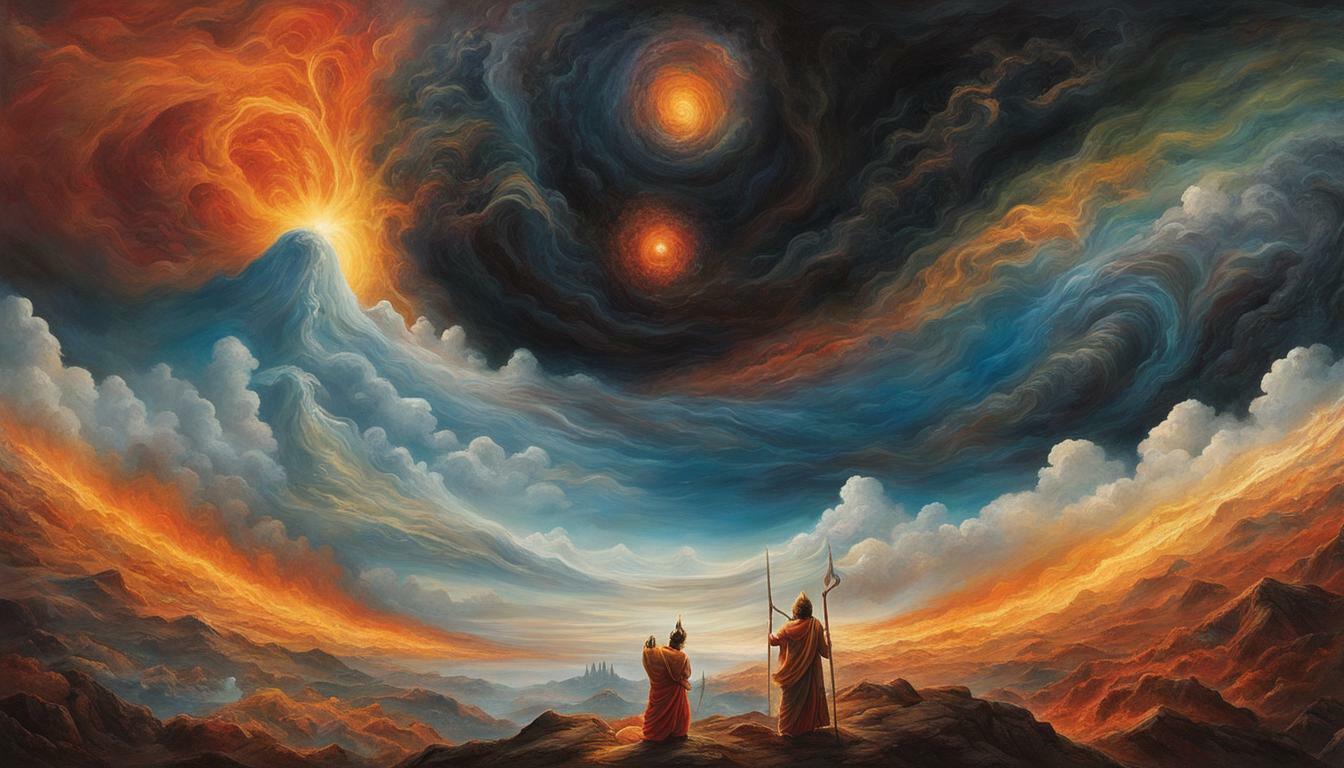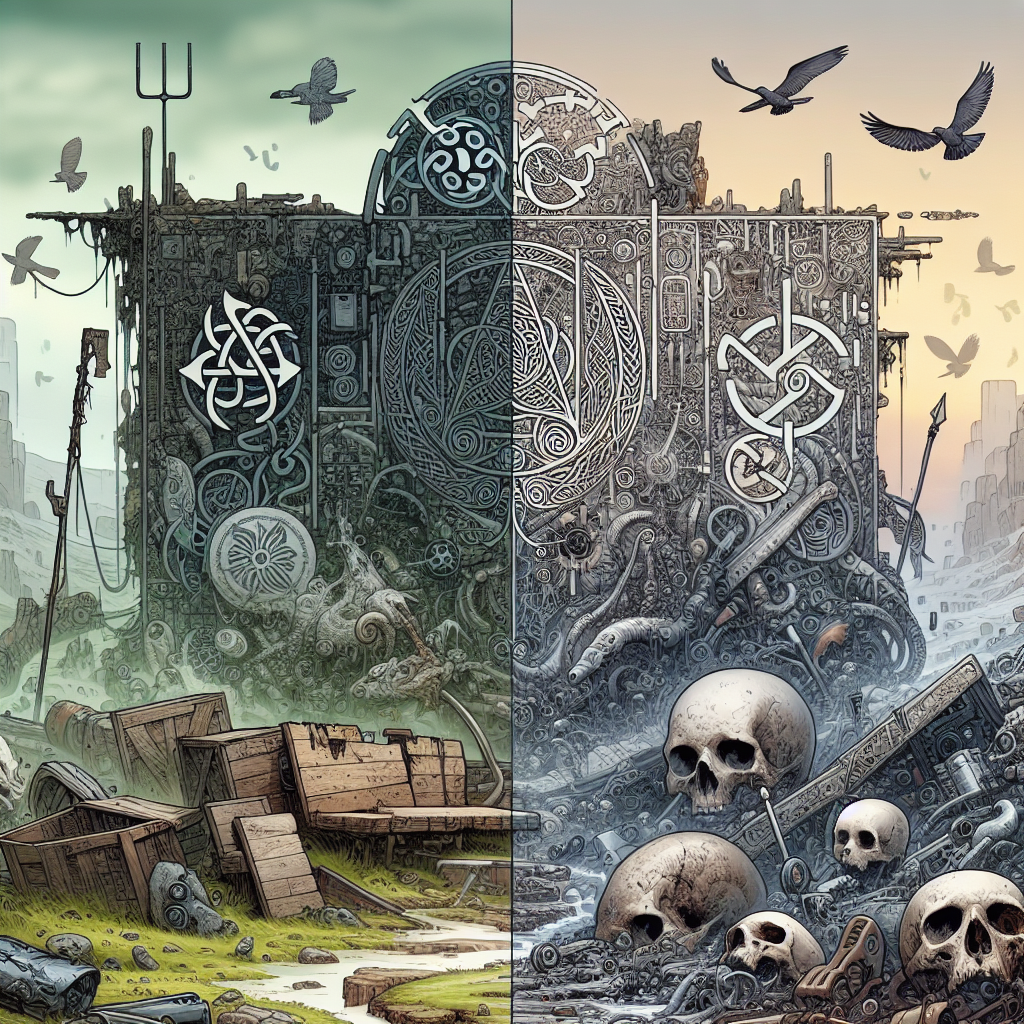Factual data: Jainism and Hinduism are two ancient Indian religions that have similarities and differences in their beliefs about the afterlife. Jains believe in the existence of the universe in material form and consider everything to fall into the categories of living souls and non-living objects. They believe in the cycle of birth and death and view death as a continuation of the rebirth cycle. The soul immediately goes to its next body after death, and depending on accumulated karma, the next body may not be human. Liberation from the cycle of reincarnation can occur when the soul achieves enlightenment and is completely free of karma, leading to an existence in the Supreme Abode.
Hinduism, on the other hand, believes in the merging of souls back into the supreme soul or Brahman. After death, souls enter heaven or paradise for an eternity of bliss. The focus of liberation in Hinduism is the merging of individual souls into the supreme soul. While Jainism focuses on the liberation of individual souls without merging, Hinduism focuses on the merging of souls into the supreme soul.
Overall, while both Jainism and Hinduism have similar concepts of the afterlife such as the cycle of birth and death and the idea of liberation, they differ in their beliefs about the ultimate goal of the afterlife and the nature of existence after death.
Key Takeaways:
- Jainism and Hinduism have distinct beliefs about the afterlife.
- Jains believe in the cycle of birth and death, with the soul immediately transitioning to its next body after death.
- Hinduism focuses on the merging of individual souls into the supreme soul after death.
- Jains aim for liberation without merging, while Hindus aim for merging with the supreme soul.
- The ultimate goal of the afterlife and the nature of existence after death differ between Jainism and Hinduism.
Understanding Jain Afterlife Beliefs
Jainism, one of the oldest religions in the world, holds unique beliefs about the afterlife. According to Jain philosophy, the universe exists in both material and spiritual forms, with everything classified as living souls (jivas) or non-living objects (ajivas). In Jainism, the cycle of birth and death plays a significant role in the understanding of the afterlife.
When a Jain individual passes away, their soul immediately moves on to its next body. This belief in reincarnation is based on the concept of accumulated karma, which determines the quality and form of the soul’s next existence. It is interesting to note that the next body for the soul may not necessarily be that of a human, as the accumulated karma can assign it to different life forms.
The ultimate goal in Jainism is liberation from the cycle of rebirth, referred to as moksha. This liberation can only be achieved when the soul attains enlightenment and is completely free from karma. Once liberated, the soul resides in the Supreme Abode, in a state of eternal bliss and peace.
| Jain Afterlife Beliefs | |
|---|---|
| Cycle of birth and death | Reincarnation based on accumulated karma |
| Moksha | Liberation from rebirth cycle through enlightenment |
| Supreme Abode | Eternal existence in a state of bliss |
Summary:
Jainism believes in the cycle of birth and death, with souls immediately moving on to their next bodies after death. Reincarnation is based on accumulated karma, which determines the form of the soul’s next existence. The ultimate goal is liberation from the cycle of rebirth through enlightenment, leading to an eternal existence in the Supreme Abode.
Exploring Hindu Afterlife Beliefs
Hinduism, one of the oldest religions in the world, has a unique perspective on the afterlife. According to Hindu philosophy, the cycle of birth and death, known as samsara, is a fundamental aspect of existence. Hindus believe in the concept of reincarnation, where the soul continues to take on new bodies after death. This cycle is influenced by the accumulation of karma, the consequences of one’s actions in life.
After death, Hindus believe that the soul enters a realm known as heaven or paradise, where it experiences the fruits of its good deeds. This heavenly existence is said to be eternal and blissful. However, it is important to note that this state is not considered permanent in Hinduism.
The ultimate goal in Hinduism is liberation, known as moksha. Moksha involves the merging of the individual soul with the supreme soul, Brahman. It is believed that through spiritual practices, meditation, and self-realization, one can attain moksha and break free from the cycle of birth and death. This liberation is seen as the highest state of existence, where the individual soul realizes its true nature and unites with the divine.
Key Beliefs in Hindu Afterlife:
- Concept of reincarnation and the cycle of birth and death
- Existence in heavenly realms after death
- Goal of attaining moksha, the liberation from samsara
- Merging of the individual soul with the supreme soul, Brahman
| Hindu Afterlife Beliefs | Jain Afterlife Beliefs |
|---|---|
| Reincarnation | Cycle of birth and death |
| Existence in heavenly realms | Existence in the Supreme Abode |
| Goal of attaining moksha | Goal of liberation without merging |
| Merging of the individual soul with the supreme soul | – |
In summary, Hinduism presents a complex and nuanced understanding of the afterlife, encompassing ideas of reincarnation, heavenly existence, and the ultimate goal of liberation. While Jainism shares similarities with Hinduism in terms of the cycle of birth and death, it differs in its emphasis on individual liberation without the merging of souls. Understanding these distinct beliefs is crucial for gaining insights into the diverse spiritual traditions of ancient India.
Similarities and Differences Between Jain and Hindu Afterlife Beliefs
Jainism and Hinduism, two ancient Indian religions, share some common beliefs about the afterlife while also having distinct differences. Both religions acknowledge the concept of a cycle of birth and death, understanding that existence continues beyond physical death. However, their perspectives on the ultimate goal of the afterlife and the nature of existence after death diverge.
In Jainism, the cycle of birth and death is central to its afterlife beliefs. Jains view the soul as an eternal entity that transmigrates from one body to another based on accumulated karma. Upon death, the soul immediately moves on to its next physical form, which may not necessarily be human depending on the karma. The ultimate goal of the afterlife in Jainism is liberation from this cycle of reincarnation, known as moksha. Liberation is achieved when the soul attains enlightenment and is freed from all accumulated karma, leading to an existence in the Supreme Abode.
In Hinduism, the afterlife beliefs focus on the merging of individual souls with the supreme soul, Brahman. After death, souls are believed to enter heaven or paradise, where they experience eternal bliss. The objective of liberation in Hinduism is the merging of individual souls into the divine, transcendent reality. Unlike Jainism, Hinduism emphasizes the unity and oneness of all existence, aiming for the individual soul to merge back into the divine source.
While Jainism and Hinduism share similarities such as the belief in the cycle of birth and death and the idea of liberation, they differ in their understanding of the ultimate goal of the afterlife and the nature of existence after death. Jainism seeks individual liberation without merging, while Hinduism emphasizes the merging of souls into the supreme soul. These distinct perspectives reflect the unique philosophical and spiritual paths within these ancient Indian religions.
| Jainism Afterlife Beliefs | Hinduism Afterlife Beliefs |
|---|---|
| Cycle of birth and death | Cycle of birth and death |
| Individual liberation from reincarnation | Merging of souls into the supreme soul |
| Existence in the Supreme Abode | Heaven or paradise |
Summary:
- Jainism and Hinduism have similarities and differences in their afterlife beliefs.
- Both acknowledge the cycle of birth and death.
- Jainism focuses on individual liberation without merging, while Hinduism emphasizes the merging of souls into the supreme soul.
- Jainism seeks existence in the Supreme Abode, while Hinduism envisions heaven or paradise.
Differences Between Jain and Hindu Afterlife Beliefs
While Jainism and Hinduism share some similarities in their beliefs about the afterlife, they also have significant differences. One of the key differences lies in their views on moksha, the ultimate goal of liberation.
In Jainism, moksha is seen as the achievement of enlightenment and the complete eradication of karma. It represents the soul’s liberation from the cycle of birth and death, leading to an existence in the Supreme Abode. Jainism emphasizes the individuality of the soul and its ability to attain liberation without merging with a supreme soul or any divine entity.
In contrast, Hinduism focuses on the merging of individual souls into the supreme soul, known as Brahman. After death, Hindus believe that the soul enters heaven or paradise for an eternity of bliss. The aim of liberation in Hinduism is the reunification of the individual soul with the universal soul, resulting in the end of all individual existence.
The nature of existence after death is another area where Jainism and Hinduism differ. Jains believe in the immediate transmigration of the soul after death, based on the individual’s accumulated karma. The next body may not necessarily be human, as it depends on the actions and deeds of the previous life. Hinduism, on the other hand, views the afterlife as a continuation of the soul’s journey towards eventual merger with the supreme soul, with the possibility of being reborn in various forms until reaching that state of union.
| Jain Afterlife Beliefs | Hindu Afterlife Beliefs |
|---|---|
| Focus on individual liberation | Focus on merging with the supreme soul |
| Immediate transmigration of the soul | Continuation of the soul’s journey towards merger |
| Emphasis on eradication of karma | Emphasis on reunion with the universal soul |
- Jainism and Hinduism both believe in the cycle of birth and death
- Jainism emphasizes individual liberation without merging
- Hinduism focuses on merging individual souls into the supreme soul
“In Jainism, the goal is to free the soul entirely from karma and achieve enlightenment, whereas in Hinduism, the goal is to merge with the supreme soul and attain ultimate union.”
Conclusion
In summary, Jainism and Hinduism have distinct beliefs about the afterlife. Jainism focuses on individual liberation and the eradication of karma, while Hinduism highlights the merging of souls with the supreme soul. Both religions acknowledge the cycle of birth and death, but Jainism sees it as a continuation of the rebirth cycle, whereas Hinduism views it as a journey towards reunion with the universal soul. Understanding these differences is crucial for appreciating the diverse perspectives on the afterlife within these ancient Indian religions.
Differences Between Jain and Hindu Afterlife Beliefs
In the realm of afterlife beliefs, Jainism and Hinduism have distinct perspectives that set them apart. While both religions share a belief in the cycle of birth and death and the eventual liberation of the soul, their views on the ultimate goal of the afterlife and the nature of existence after death differ significantly.
In Jainism, the afterlife is seen as a continuation of the cycle of rebirth. After death, the soul immediately moves on to its next body, which may not necessarily be human depending on the accumulated karma. The goal for Jains is to achieve enlightenment and liberation from the cycle of reincarnation, known as moksha. When the soul is completely free of karma, it is believed to reside in the Supreme Abode, free from the shackles of the material world.
Hinduism, on the other hand, emphasizes the merging of individual souls back into the supreme soul or Brahman. After death, souls are believed to enter heaven or paradise, where they experience eternal bliss. The focus of liberation in Hinduism is the merging of individual souls into the supreme soul, rather than individual liberation. The ultimate goal is to dissolve the individual identity and become one with the divine.
While both Jainism and Hinduism share concepts such as the cycle of birth and death and the idea of liberation, their contrasting beliefs about the afterlife highlight the diversity of religious thought in India. Understanding these differences can foster a deeper appreciation for the unique perspectives offered by each religion.
FAQ
What are the differences between Jain afterlife and Hindu afterlife beliefs?
Jainism believes in the cycle of birth and death, with the soul immediately moving on to its next body after death. Hinduism, on the other hand, focuses on the merging of souls into the supreme soul or Brahman after death.
What does Jainism believe about the afterlife?
Jains believe in the existence of the universe in material form and view everything as falling into the categories of living souls and non-living objects. They believe in the cycle of birth and death, with the soul immediately transitioning to its next body after death.
What does Hinduism believe about the afterlife?
Hinduism believes in the merging of individual souls back into the supreme soul or Brahman after death. Souls may enter heaven or paradise for an eternity of bliss before achieving this ultimate liberation.
Are there any similarities between Jain and Hindu afterlife beliefs?
Yes, both Jainism and Hinduism believe in the cycle of birth and death, and the concept of karma plays a crucial role in their afterlife beliefs. Both religions also emphasize the importance of achieving liberation from the cycle of reincarnation.
How do Jain and Hindu afterlife beliefs differ?
Jainism focuses on the liberation of individual souls without merging, while Hinduism focuses on the merging of souls into the supreme soul. Jainism views the ultimate goal of the afterlife as achieving enlightenment and existence in the Supreme Abode, whereas Hinduism seeks the merging of individual souls into the supreme soul or Brahman.



